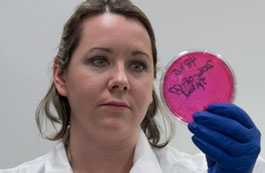Recent Outbreaks
Since January, CDC has been assisting with the investigation of two outbreaks of infections caused by Elizabethkingia anophelis in the Midwest. Although Elizabethkingia is a common organism in the environment, it rarely causes infections. CDC is assisting with testing samples from patients and a variety of potential sources, including healthcare products, water sources and the environment; to date, none of these have been found to be a source of the bacteria. CDC will continue to work with health departments in the affected states to identify the source of the bacteria and develop ways to prevent these infections.

Update 4-20-2016: Cluster of Elizabethkingia anophelis cases in Illinois
CDC and the Illinois Department of Public Health (IDPH) are investigating a cluster of infections caused by Elizabethkingia anophelis in 10 Illinois residents who have been diagnosed since Jan. 1, 2014. The strain of E. anophelis in this cluster is different from the strain that is causing the outbreak in Wisconsin. Six of the 10 patients have died. However, IDPH is unable to determine if Elizabethkingia was the cause of death because many of those individuals had underlying health conditions.
The cases were identified after IDPH sent alerts to Illinois hospitals and laboratories in early February and again in March requesting that they report all cases of Elizabethkingia going back to the beginning of 2014. Recent CDC testing of the specimens confirmed that the same strain made the 10 people sick but that the strain is distinct from the strain that has been identified in Wisconsin.
Illinois health officials continue to collect case histories and other information to try to find a connection among these patients. Previously, health providers were not required to report individual cases of Elizabethkingia, so it is difficult to determine the degree and kind of exposure that results in illness. For the same reason, it is difficult to estimate how many cases of illness actually occur each year.
Investigation into the Wisconsin outbreak has led to increased awareness of Elizabethkingia and additional reporting of cases to CDC. Technological advancements in laboratory testing have allowed scientists to differentiate Elizabethkingia anophelis from other types of Elizabethkingia and to identify patient clusters within this species. As CDC and state health department’s work together to investigate these outbreaks, other clusters may be identified.
Healthcare providers in Illinois should be aware of the recently-identified cluster and consider Elizabethkingia as a potential cause of bloodstream infections among patients.
Related Link:
Multi-state cluster of Elizabethkingia anophelis in Wisconsin, Michigan and Illinois
As of June 16, 2016
Current Case Counts
| State | Number of confirmed cases (includes deaths)* | Number of deaths among confirmed cases* |
|---|---|---|
| Wisconsin | 63 | 18 |
| Michigan | 1 | 1 |
| Illinois | 1 | 1 |
CDC, the Wisconsin Department of Health Services (WDHS), the Michigan Department of Health and Human Services (MDHHS), and the Illinois Department of Public Health (IDPH) are investigating an outbreak of infections caused by a bacterium called Elizabethkingia anophelis, which is usually found in the environment. The majority of the infections identified to date have been bloodstream infections, but some patients have had Elizabethkingia isolated from other sites, such as their respiratory systems or joints.
The majority of the patients who have had Elizabethkingia infections as part of this outbreak are over the age of 65 years, and all have had serious underlying health conditions. It has not been determined whether the deaths associated with this outbreak were caused by the bacterial infection, the patients’ underlying health conditions, or both.
Wisconsin was first notified of six potential cases between December 29, 2015 and January 4, 2016 and set up statewide surveillance on January 5, 2016. CDC issued a nationwide call for cases on January 20, 2016, via the Emerging Infections Network and again on March 2, 2016, via the Epidemic Information Exchange system, also known as Epi-X. These alerts asked states to look for any infections similar to the ones reported in Wisconsin, and to send isolates from any potential cases to CDC for testing to determine if they match the bacteria causing infections in Wisconsin.
In response to the outbreak of Elizabethkingia infections in Wisconsin, Michigan sent a state health alert on February 8 , 2016 asking providers and laboratories to review records for Elizabethkingia specimens identified since January 1, 2014. On February 29, 2016, the MDHHS Bureau of Laboratories received an Elizabethkingia from a recently submitted blood sample and forwarded the isolate to CDC for additional testing, where it was determined to match the bacteria causing the outbreak in Wisconsin.
Illinois sent alerts to hospitals on February 10 and March 29, 2016 requesting they report all cases of Elizabethkingia and save any specimens for possible testing at public health laboratories. To date, only one isolate from Illinois has matched the bacteria causing the outbreak in Wisconsin.
Although Elizabethkingia is a common organism in the environment (water and soil), it rarely causes infections. CDC is assisting with testing samples from a variety of potential sources, including healthcare products, water sources and the environment; to date, none of these have been found to be a source of the bacteria.
CDC will continue to work with WDHS, MDHHS, and IDPH to identify the source of the bacteria and develop ways to prevent these infections.
Related Links
Related Links
- Page last reviewed: June 16, 2016
- Page last updated: June 16, 2016
- Content Source:


 ShareCompartir
ShareCompartir